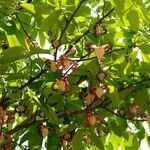Tree or shrub 3.6–30 m. tall, with trunk up to 1 m. in diameter, fissured at the base; bark grey, vertically corrugated with rounded ridges; branchlets glabrous.. Leaf-blades obovate-elliptic, obovate-oblong or elliptic, 5.5–60 cm. long, 2.5–20 cm. wide, shortly acuminate at the apex, rounded or cordate at the base, thin to coriaceous, glabrous, glaucous with a purplish bloom on the upper surface and often glaucous beneath; midrib often red beneath; lateral nerves 10–23, prominent on both surfaces; venation reticulate, prominent; petiole channelled, 0.5–1.5 cm. long.. Flowers solitary, extra-axillary or rarely axillary, hanging, fragrant; pedicels (modified branches fide Dale & Eggeling) 5–25 cm. long, glabrous, at first reddish-white, then yellowish; bracteoles green, ovate-lanceolate or broadly ovate, 1.8–4 cm. long, 0.9–3.7 cm. wide, acuminate at the apex, attenuate and subcordate at the base, glabrous or sometimes ciliate at the margins.. Sepals green or reddish or green with reddish spots, oblong-lanceolate, 2–3.5 cm. long, 0.5–1 cm. wide,obtuse, the margins reflexed, crispate-undulate, glabrous.. Outer petals white, yellow or greenish-yellow spotted with dark red or carmine, ovate-lanceolate, 4–10.5 cm. long, 2.5–3 cm. wide, attenuate at the apex, spreading at the base, curved, with crispate undulate margins, glabrous; inner petals white, greenish-white or cream with dark red, purplish-brown or carmine spots, broadly ovate, 3–5 cm. long, 2.5–3 cm. wide, attenuated at the apex, subcordate or auriculate at the base, subsessile or with claw 3–8 mm. long, margins and auricles with pale ferruginous hairs, sometimes lightly adhering at the tips to form a cone.. Stamens subglobose, 0.5 mm. long.. Ovary conical, 3–4 mm. long, glabrous.. Fruiting pedicels up to 25(–60) cm. long, 1–3.5 cm. thick; fruit green then blackish-brown, globose, 10–22.5(–30 fide Machin) cm. in diameter, or ovoid, 14–22.5 cm. long, 10–15 cm. wide, longitudinally striate-rugose, glabrous, the pericarp thick and woody.. Seeds brown, ovoid, ellipsoid or oblong-ellipsoid, (1.2–)2–3 cm. long, 0.8–1.5 cm. wide, 6–10 mm. thick, rugose, embedded in a fragrant pulp.
More
A tree. It grows 35 m tall. The trunk is clear and can be 2 m around. The branches are horizontal. The bark is thin and smooth. The leaves droop. They are thick and alternate. The leaves are larger than M. tenuifolia. The leaf stalk is thick and 1 cm long. The leaf blade is oblong and 45 cm long by 20 cm wide. There are 20 pairs of side veins. The flowers occur singly at the base of new shoots. The flower stalk is 20 cm long. It has a leaf like bract about 1/3 from the top. The flowers are large and hang down. The flowers are red and yellow and hang from the stalks. They have a smell. The petals can be 10 cm long and have red, yellow or green spots. The fruit are the size of a softball. It can be 20 cm across. It hangs on a long stalk. It has several seeds embedded in whitish, sweet smelling pulp. The seeds are oblong and 1.5 cm long. They are pale brown. The seeds are edible. Flowers are pollinated by insects.
Petals yellow and red, the three inner spotted red outside and green inside
A tree, up to 60 ft. with large fragrant flowers

